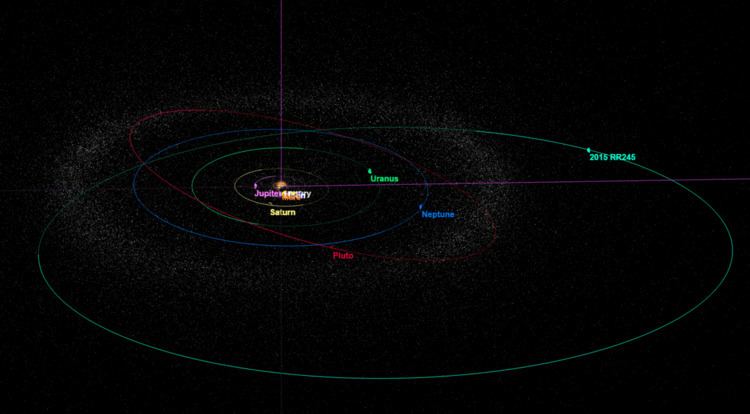Discovery date 10 July 2016 Aphelion 129.82 AU (Q) Semi-major axis 81.86 ± 0.05 AU (a) | MPC designation 2015 RR245 Perihelion 33.90 AU (q) | |
 | ||
Discovered by M. T. Bannister, J. J. Kavelaars, B. J. Gladman, J.-M. Petit, T. Burdullis. Measurers S. D. J. Gwyn, Y.-T. Chen, M. Alexandersen | ||
2015 RR245 is a possible dwarf planet in the Kuiper belt. 2015 RR245 is one of the few dwarf planets to survive after the formation of the solar system, along with Pluto and Eris. It was discovered in February 2016 by the Outer Solar System Origins Survey (OSSOS).
2015 RR245 was discovered by a research team while poring over images that the Canada–France–Hawaii Telescope in Hawaii took in September 2015 as part of the OSSOS (Outer Solar System Origins Survey).
Its exact size is uncertain, but the best estimate is around 670 km (420 mi) in diameter, assuming an albedo of 12%. For comparison, Pluto, the largest object in the Kuiper belt, is about 2,374 km (1,475 mi) in diameter.
Orbit
As of December 2016, the orbit of 2015 RR245 is known reasonably well. It has a 733-year orbit. It appears to come as close as 33.9 AU to the Sun (still beyond the orbit of Neptune at 30 AU), and up to 130 AU distant. It will make its closest approach to the Sun in 2096.
Additional precovery astrometry from the Sloan Digital Sky Survey and the Pan-STARRS1 survey shows that 2015 RR245 is securely trapped in a 2:9 mean motion resonance with Neptune, meaning that 2015 RR245 orbits the Sun twice in the same amount of time it takes Neptune to complete 9 orbits.
2015 RR245 is unlikley to have been trapped in the 9:2 for the age of Solar System. It is much more likely that it has been hopping between various resonances and got trapped in the 9:2 resonance in the last 100 million year.
